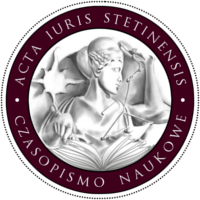






| Authors: |
Jakub
Zwierzchowski

Szkoła Doktorska Uniwersytet Śląski, China University of Political Science and Law Joanna Sobiecka 
Akademia Wychowania Fizycznego im Bronisława Czecha w Krakowie |
| Keywords: | integration sports law Polish sports association Paralympics athletes with disabilities |
| Whole issue publication date: | 2024-06 |
| Page range: | 21 (123-143) |
| Downloads ?: | 362 |
| 1. | Badura M., Basiński H., Kałużny G., Wojcieszak M. (eds.), Ustawa o sporcie. Komentarz, Warsaw 2011. |
| 2. | Bouttet F., Inclusion as a Norm. Multi−Scalar Influences on the Recognition of People with Disabilities in French National Sports Organisations, “Loisir et Société/Society and Leisure” 2016, No. 39(2). |
| 3. | Cajsel W., Ustawa o sporcie. Komentarz, Warsaw 2011. Cunningham G., Diversity and Inclusion in Sports Organisations. Multilevel Perspective, New York 2015. |
| 4. | Gawroński W., Sobiecka J., The Development of Medical Care in Polish Paralympic Sport, “Med Rehabil” 2018, No. 22(4). |
| 5. | Kirenko J., Narodziny rehabilitacji jako nauki i jej wpływ na poprawę życia i pracy osób z niepełnosprawnościami, “Kwartalnik Niepełnosprawność – Zagadnienia, Problemy, Rozwiązania”, 2020, No. II (35). |
| 6. | Kitchin P., Crossin A., Understanding which Dimensions of Organisational Capacity Support the Vertical Integration of Disability Football Clubs, “Managing Sport and Leisure” 2018, No. 23(1–2). |
| 7. | Kowalik S., Integracja osób z niepełnosprawnością, in: K. Klukowski, J. Nowotny, A. Czamara (eds.), Słownik fizjoterapii. Mianownictwo polsko–angielskie i angielsko–polskie z definicjami, Warsaw 2014. |
| 8. | Kowieska U., Uwarunkowania rozwoju sportu osób niepełnosprawnych w Polsce, “Med Sport” 1999, No. 15 (98). |
| 9. | Krześniak E., Ustawa o sporcie. Komentarz, Warsaw 2020. |
| 10. | Pawłowski R., Prawo sportowe. Struktury organizacyjne sportu, Kielce 2021. |
| 11. | Sobiecka J., Plinta R., Kądziołka M., Gawroński W., Kruszelnicki P., Zwierzchowska A., Polish Paralympic Sports in the Opinion of Athletes and Coaches in Retrospective Studies, “International Journal of Environmental Research and Public Health” 2019, No. 16(24) 4927. |
| 12. | Sobiecka J., Sport inwalidów – wyobcowany krąg ludzi?, “Postępy Rehabilitacji” 1999, No. 13(3). |
| 13. | Sobiecka J., The Process of Integrating Polish Sports Communities, “Medical Rehabilitation” 2020, No. 24. |
| 14. | Sørensen M., Khars N., Integration of Disability Sport in the Norwegian Sport Organisations: Lessons Learned, “Adapted Physical Activity Quarterly” 2006, No. 23(2). |
| 15. | Valet A., About Inclusive Participation in Sport: Cultural Desirability and Technical Obstacles, “Sport in Society” 2018, No. 21(1). |
| 16. | Van Hoecke M., Ost F. (eds.), Methodologies of Legal Research. Which Kind of Method for What Kind of Discipline, Oxford 2011. |
| 17. | Wicker P., Breuer C., Exploring the Organisational Capacity and Organisational Problems of Disability Sport Clubs in Germany Using Matched Pairs Analysis, “Sport Management Review” 2014, No. 17(1). |
| 18. | Zwierzchowska A., Krużyńska A., Deaflympics alienacja czy integracja?, in: M. Wilski, J. Gabryelski (eds.), Idee olimpijskie a kierunki rozwoju sportu osób niepełnosprawnych, Poznań 2013. |